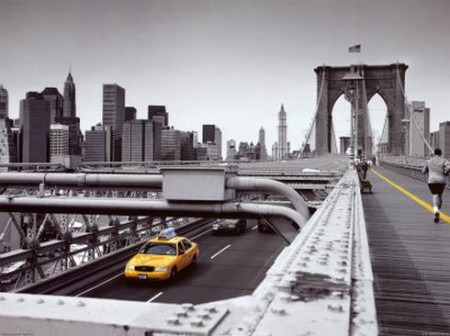The Battery, Central Park, the Empire State Building, Metropolitan Museum of Art, Museum of Natural History, Museum of the City of New York, New York Public Library, Radio City, Wall St., and many others.
If those who originally planned the streets of New York had possessed enough imagination to foresee the down-town habit of the present day, no doubt they would have arranged matters differently. They fancied that the city would be a great shipping center, a seaport; and that people would need many streets running toward the water on either side.
Moreover, the long backbone of Manhattan, being high ground from which there was a general slope away toward the rivers, must have suggested that the natural drainage and sewerage of the city would be along the many ribs or streets running east and west. No one thought then that in a comparatively few years half the population would, morning and evening, be moving along the ridge of the island, crowding, clutching, struggling with one another, like so many ants traveling along the narrow top of a fence rail.
A glance at the map will show the peculiar disposition of the land. And it will also show hundreds of streets running east and west from river to river; but, at its widest part (Fourteenth Street), only seventeen avenues running north and south, and the majority of these not available for through traffic. The map, when taken in connection with the accepted idea of most New Yorkers that business must be transacted within a stone’s throw of Wall Street and living must be carried on in the neighborhood of the Central Park, will explain, readily enough, why there is so much friction during the “rush” hours. Hundreds of thousands of human ants want to pass along the fence rail at the same time. The transportation of a million or more people a day from one point to another along the high ridge of crowded Manhattan is no easy task. They say in London or Paris or Berlin, with a little air of superior experience, that they do things differently over there. True enough, but the chances are they could not do this kind of thing at all.
The movement of these large bodies of people along the ridge begins early in the morning. From seven until ten o’clock one may notice the drift of people in the side streets toward the main thoroughfares. Men hurry along for a block or so and then disappear down a subway entrance, or up the steps of an elevated station, or they turn down an avenue to wait for a surface car.
The surface lines along Third, Fourth, Sixth, and Seventh Avenues are always crowded with passengers from Harlem down as far as Union Square; but they are not usually taken by people who are moving toward the lower part of the city. They are not fast enough and are subject to being held up at every street crossing. The crowd in them is “getting to business” in the up-town stores and offices, or else is coming down from the region of the park to shop or travel or keep some form of engagement.
It changes completely every few years in the endeavor to accommodate itself to the increased demand; but the crowd keeps growing faster than human wit can devise larger and better means of transportation. The foreign visitor who stands agape at this packing of cars has not the smallest idea of the problem presented. It is not the moving of a few thousand people at leisure, but the carrying each day of nearly two million passengers in the borough of Manhattan alone, and the bulk of them during the “rush” hours at morning and evening. The squeezed and jammed and jellied public knows something about this, and, sensibly enough, agrees to accept the inevitable.
The volume of this up-town crowd of buyers, travelers, clerks, managers, typewriters, and shop girls that fill the surface cars in the early morning is by no means insignificant. It is really enormous, almost as great as the crowd that gathers in the neighborhood of Wall Street. For it is an exaggeration to say that all business is done down town. There are many large banks, insurance companies, printing-offices and wholesale houses, to say nothing of the retail shops, in the upper city. Then too, most of the railroading, manufacturing, and shipping is carried on along the upper east and west sides.
And though all the surface cars in the morning going down town are filled to overflowing, the returning cars are not entirely empty. There are stray currents of humanity that help restore the lost balance — people who for one reason or another move in an opposite direction to the main streams. Harlem and beyond are not deserted when the Stock Exchange opens. Some business, some traffic is going on all over the city, at all times.
However, the main currents in the early morning set toward Wall Street and they find the lines of most resistance but of least time by way of the elevated roads and the subways. The crush on these through lines is similar to that on the surface cars. Train after train hums and rattles its way into the station to find a long wall of humanity lined up on the platform ready to board it. There is a clank of gates or the slam of an iron door, a few apologetic-looking people respond to the guard’s call of “Passengers off first”; then there is an “All aboard,” followed by a steady stream of people pouring in at each end of each car. The gates slam shut, the signal cord is jerked violently, the train with its electric power responds with another jerk, and is quickly under way. After half a dozen stops the train is filled, and if it is an express it runs through to The Bridge or Rector Street or South Ferry; if it is a local, it continues adding passengers, until the aisles and platforms are crowded, and people are hanging by straps as in the surface cars.
It is the same good-natured, tolerant crowd, whether met with on the surface and elevated roads, or in the subways. It stands jostling, pushing, elbowing with the utmost composure, each one knowing very well that he himself cannot get in or get out without doing the same thing. It even tries to be indifferent, looks out of the window or, more often, hides its face in the morning paper, if the crush is not too violent for the use of its hands. But the morning paper is not taken very seriously.
The disembarked hastens downstairs to the street or scrambles upstairs out of the subway, as the case may be, and there it meets and mingles with the larger moving throng of the lower city. Whence came this greater throng? How did it arrive here? What was its method of transit? To answer such questions one has only to remember that the island of Manhattan does not begin to furnish houses and homes for all the people that do business in the city. There is a great host living on the outskirts, in the suburbs, within a radius of thirty miles of the City Hall, that comes and goes each day with more regularity than the tides in the harbor. This does not mean merely the contingent living to the north of the city in Westchester, or along the sound in Connecticut, though the representation from there is vast enough in proportions to fill the trains from Forty-Second Street down to the lower city. The streams of humanity flowing from that water-shed are very large and yet apparently they dwindle into insignificance compared with what pours in from Long Island.
Up through Brooklyn and along the great bridges there is continuous travel by trolley, motor, and foot, from early in the morning. Before nine o’clock the tide is at its flood. Around the New York exit of the Brooklyn Bridge the currents from many directions meet and mingle to make a veritable whirlpool of humanity that circles and eddies, foams and dashes, gets mixed up in a roaring swirl, then collapses in froth, dissipates, and finally trickles away in small streams to various points of the compass. Of course there is a blocking of traffic, and occasionally an accident, due to the rush off or on the cars, that produces confusion, excitement, loud protest, or angry denunciation. But this, though a not unusual occurrence, always leaves the pushed and hustled crowd more or less indifferent. Everyone knows that the thoroughfares are insufficient during “rush” hours; but they do not know how matters can be helped.
There is less of a crowd at the Williamsburgh Bridge because it is not the most direct route to the lower part of the city. It is one of the ways by which those who do business in the middle Broadway region travel, and it contributes its sum to the mass that each morning moves into the city; but it lends not directly to the congestion of the lower town. Still, though it is not a direct way, it adds something, like the ferries beneath it that keep coming and going from shore to shore. Time was when the ferries at South and Wall and Fulton streets were the only means of getting into the lower town from Brooklyn, and they were then, in the morning hours, often loaded with people to the gunwales; but since the building of the new bridges and the opening of the Battery tube, they have been used but little. Eventually their occupation will be gone completely.
Thousands upon thousands swarm into the city from Long Island. Bridges creak and ferries strain and tunnels roar with the weight of them; and the rasp and shuffle of their feet along the decks, along the bridge approaches, and along the flagged streets help make that deep undertone of the city to which the electric cars add the high note.
Yet Brooklyn and beyond is only one source of intake. The shores of the Upper Bay, Staten Island, Coney Island, send up their quota by steamer and ferry-boat; while from the Hudson, reaching far into the state, steamboats and railways are bringing down and disembarking more thousands to swell the throng. But the body of commuters that comes in from New Jersey is, perhaps, the greatest of them all.
Probably four hundred thousand people is a moderate estimate for those who daily travel into New York from across the Hudson. It is nearer, no doubt, to a million. The local trains on all the railways through New Jersey are crowded from seven to ten in the morning, and the double-decked ferries that push and snort and whistle their various ways from shore to shore look black with massed humanity.
Again, as on the East River side, there are long tunnels under the Hudson, carrying passengers in swift electric cars; and these are lessening the crush on the ferries for the time being, but it will not be long before both tunnels and ferries are once more inadequate. The population in New Jersey that comes and goes daily to New York is increasing by thousands each year, and the greater the ease in getting to town, the better the traveling facilities, the more people there are willing enough to live in the country in preference to the crowded quarters of the upper city.
Visits: 90



